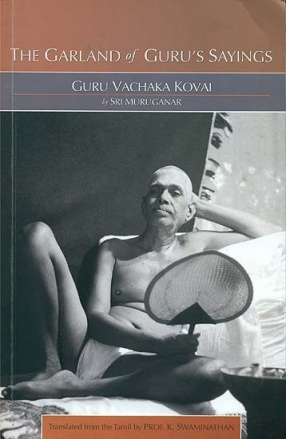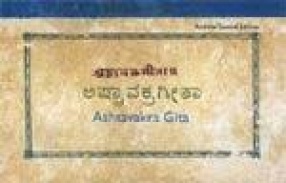
Sri Ramanasramam Tiruvannamalai

Showing all 24 books














Kunjuwswami was a shining personality whose life from its youth revolved around the Sun of Jnana. Bhagavan Sri Ramana Maharshi. He came to Sri Bhagavan in 1920, while still in his teens, and served Him till His nirvana in 1950.
Kunjuswami’s Reminiscences provide a rare, first –hand account of the early days of Sri Ramanasramam and life at Skandasramam.
The author imbibed the teachings of his Master, took them to heart and dedicated his life to their ...

This slim book is indeed a gem, a boon for sadhakas of Self – Enquiry as taught by the Bhagavan Ramana. Written in 1962 by a devote who was for many years in the Presence of Ramana and earnestly practiced his teaching, this book, a first-class sadhakas’ manual, anticipated every question that is apt to arise in the mind of the practicant and answers them all in Bhagavan’s own words, mostly culled from Talks With Sri Ramana Maharshi.
Every ...



The English version of the Yoga Vasishta Sara is based on a translation made by Swami Sureshananda, and old devotee of Bhagavan, who has founded an ashram named 'Vijnana Ramaneeyam' at Palghat and has translated several works of Bhagavan as well as the Yoga Vasishta Sara into Malyalam. This is published by Sri Ramanasramam, during 1969 to 1971 and is now issued in the form of a book for facility of reference.


The author has packed into this small volume all of the essential information relating to the life and teachings of Bhagavan Sri Ramana Maharshi (1879-1950). The life of Sri Ramana Maharshi fills us with wonder. As a teenager, hardly seventeen, he realised the Self through a spontaneous act of Self-enquiry without any conscious effort on his part. Or any training imparted by a teacher. He left his home (at Madurai) in 1896, came to Arunachala (Tiruvannamalai) ...


Adi Sankara and other great Sages wrote several works like the commentary on the Vedanta Sutras and thus furnished the methods for those engaged in Self-enquiry to accomplish their purpose. From these, Sri Karapatra Swami later condensed the salient points into Sanskrit verse in a work of twelve chapters, called Sri Advaita Bodha Deepika. In this work the author has explained how Ignorance obscures the true nature of the Self which is non-dual only; how by its ...

Bhagavan Sri Ramana Maharshi has revealed that perfect and eternal happiness is our real nature, and that the self-enquiry ‘Who am I?’ is the direct path through which we can attain and enjoy such happiness here and now. He Himself attained Self-Knowledge (atma-jnana) while but a sixteen-year-old schoolboy, and thereafter lived for fifty-four years as the Sadguru of countless people of all countries and all religions. This book, The Path of Sri Ramana-Part ...

Devaraja Mudaliar was a lawyer by profession. He had his first darshan of Bhagavan Ramana at the Virupaksha cave in the first decade of the twentieth century and over the years occasionally visited him. It was however much later, in the 1930.

Sri Ramana Paravidyopanishad is Vedanta Saram, the Supreme Science of the Self as taught by Sri Ramana Maharshi. It contains the Sanskrit text, English translation and commentary. The author, Sri Lakshmana Sarma, came into the fold of Bhagavan Sri Ramana in 1927. Revering him as the embodiment of both Lord Dakshinamurti and Sri Adi Sankara, he surrendered to him completely. For more than twenty years, he moved closely with the master, and under his personal ...

The author has packed into this small volume all of the essential information relating to the life and teachings of Bhagavan Sri Ramana Maharshi (1879-1950). The life of Sri Ramana Maharshi fills us with wonder. As a teenager, hardly seventeen, he realized the Self through a spontaneous act of Self-enquiry without any conscious effort on his part, or ay training imparted by a teacher. He left his home (at Madurai) in 1896, came to Arunachala (Tiruvannamalai) ...

In the 1920s and 30s Muruganar wrote Sri Ramana Sannidhi Murai, an anthology of devotional poems in praise of Sri Bhagava that was modeled on the Tiruvachakam of Manikkavachagar. These writings were titled Ramana Puranam by Bhagwan himself.

Instead of making a vain attempt to give a brief autobiography of the reknown Sage Sri Ramana Maharshi one is tempted to reproduce the glorious tribute Paul Brunton (A Search In Secret India) has paid. "The words of this Sage still flame out in my memory like beacon of lights. "I pluck golden fruit from rare meetings with wise men," wrote trans-Atlantic Emerson in his diary, and it is certain that I plucked whole basketfuls during my talks with ...

Here Kanakammal narrates a series of episodes centred on Sri Bhagavan. This is in addition to her general account of Arunachala and its greatness as well as a good explanation bringing out the specialty of Sri Bhagavan.

This Book (running into tenth edition) is based on the Sanskrit works of the Lakshmana Sarma, Sri Raman Hridayam and Guru Ramana Vachana Mala. The status of the world, the soul, the egoless state and merits of devotion are all lucidly explained so as to help the serious seeker understand the teachings of Bhagavan. The Author chooses to write under the pseudonym 'WHO'. The Book besides summarising the teachings of the sage also gives a summary of the entire ...

This book presents a varied collection of inspiring and spiritually-elevating accounts by 160 persons inclduing 28 foreigners from across the globve, who visited / interacted with Sri Ramana Maharshi.

While scripture can be potent medicine for the disease of samsara, spiritual stories are like delicious sweets giving us a direct and effortless taste of sublime spiritual truths. Ramana Mahrshi was a master chef who provided a dine feast for his devotees. Timeless parables and epic tales came alive and his gracious words and inimitable dramatizations. “Such was the attraction of these stories,†said Kunju Swami, “that when we heard Sri Bhagavan beginning a ...

Bhagavan Sri Ramana Maharshi preached silence by observing it Himself and Asramites aspiring for spiritual advancement sat at the holy feet of Bhagavan, imbibing the lessons of that silence. Occasionally Bhagavan spoke on spiritual matters. On such occasions, a few devotees recorded whatever He sad; and amongst them, Nagamma was one. When Nagamma became an Asramite, she renounced everything and whilst sitting at the feet of the Master she felt an irresistible ...

Kaivalya Navaneeta is a widely known Advaita classic in Tamil. Navaneeta means butter. Kaivalya or kevala is the state in which the soul exists, isolated from all connection with the body, etc. from the vast ocean of (the Upanishads, etc.) the great teachers have drawn the milk of wisdom and filled it in pots (ancient texts). Tandavaraya Swami, the author of Kaivalya Navaneeta says that he has extracted the butter from the milk. Those who have obtained this ...

Bhagavan Sri Ramana Maharshi often quoted from the Tripura Rahasya and considered it to be one of the greatest works expounding the traditional teaching of Advaita. This book is not to be picked up, read through and put away. The verses are full of Divine nectar which will quench the thirst of any earnest seeker who repeatedly reflects on their meaning and in right earnest, attempts to implement the teaching. In this fascinating scripture, through stories and ...

This work contains almost everything written by Bhagavan Sri Ramana Maharshi. His inspired compositions and a number of translations from ancient Advaitic texts, representing the essence of his teachings. They fall into two categories--those which exemplify the path of surrender through love and devotion to the Divine, and those which are more doctrinal. The first group includes the Five Hymns to Sri Arunachala of which the first poem, The Marital Garland Of ...
